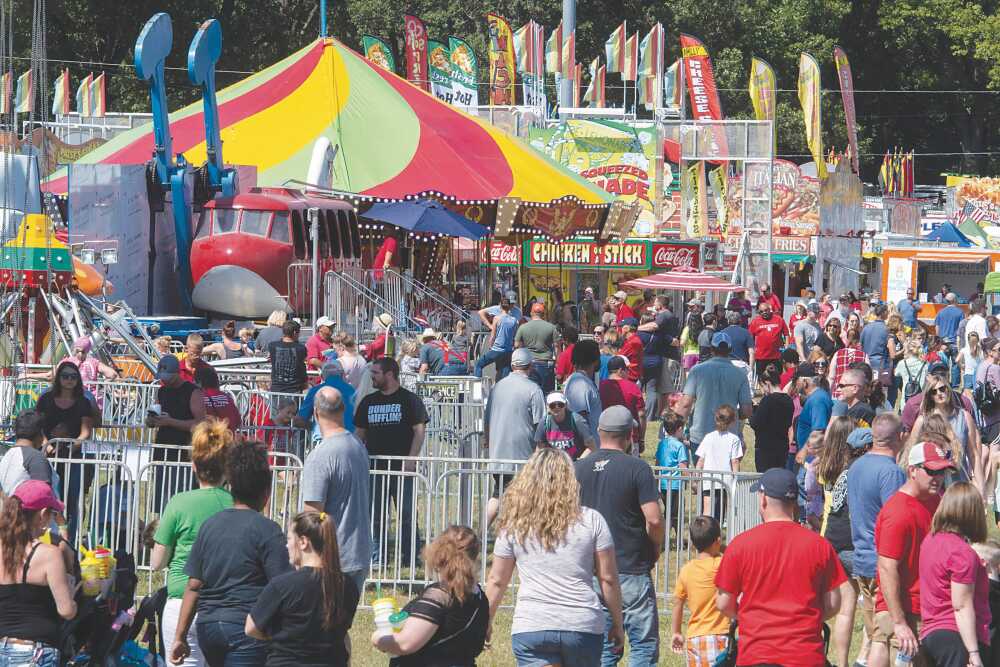Labor of Love: Not-for-profits raise money at 165th SEMO District Fair

The SEMO District Fair does much more than delight and entertain the area for eight days, it’s also a vital fundraiser for groups that make a difference in the area. Here are stories about three vendors whose products benefit those with cancer, provide support to local scouts, assist local schools, enhance amenities at local parks — and so much more. Over the years, thanks to the fair, millions of dollars have been raised that better our community in real and direct ways that most people may not realize.
Trinity Lutheran Men’s Club
Alan Haman remembers when he got started with the Trinity Lutheran Men’s Club stand at the SEMO District Fair, whose 2021 incarnation runs Sept. 11-18 at its longtime host site, Arena Park fairgrounds in Cape Girardeau.
The church is just one of the 501(c)(3) charitable organizations working the weeklong fair every year to raise funds for causes it supports.
Haman related a long-ago and vivid fair memory.

“I recall it was the late 1940s or early 1950s and, in those days, we sold soda by the bottle,” he said. “We Boy Scouts and Cub Scouts used to walk around and pick up the empties people had left behind on the fairgrounds because you could get two cents per bottle on the deposit.”
A church history of its fair involvement shows the club switched over to soda in paper cups by 1969.
Noting the fair was canceled in 2020 due to the pandemic, Haman said 2019 was his last year as a member of the Men’s Club Fair committee — which he joined in the early 1970s — with a primary responsibility for securing volunteers. This year, he’ll be a helper just like many from the church.

The Trinity Lutheran Men’s Club operates out of a hexagonal shelter across from the Arena Building and raises funds for the causes it supports by selling food cooked on site.
“About 25 years ago, we started serving breakfast, at right around 6 (a.m.),” Haman said, noting the club has breakfast (ham, eggs, pancakes, sausage) until 10:30 a.m. then switches over to lunch, which it has offered since the 1940s, for the remainder of the fair day.
“We have hamburgers, brats, sauerkraut, chili, hot dogs and soda and water,” Haman said. “Everybody wants to know why we don’t have French fries, but we don’t have room (in the stand) for a deep fat fryer, and we’re a little scared of the hot grease, fearing somebody could get hurt in the close quarters.”
Instead of fries, the Trinity men serve up chips.
Haman is reluctant to share recent fundraising totals at the fair but pointed to an old history of the stand compiled by Trinity Lutheran.
An excerpt: “Profit from the operation grew to over $1,000 by 1952, and the reported profit in 1967 was over $2,000. In 1969, $3,218.70 was netted and [by] the early eighties the profit was $6,500. Nearly $8,000 was realized in 1989.”
“Let’s just say (the stand) realizes considerably more than that now,” Haman said, who added the men’s club presence at the fair began in 1947 when it utilized a tent.
“Being at the fair started out as a fundraiser for us but over the years, with the congregation pitching in and with youth and teachers helping out, [the fair] has also become about fellowship [and] about outreach,” he said.
For the Trinity men, the proceeds realized after expenses go primarily to youth.
“We support the Boy Scouts, Girl Scouts and Saxony Lutheran High School,” he said, plus meeting several ancillary needs not so easy to detail on an Excel spreadsheet.
“When sports teams connected to Trinity need uniforms, we help with those; we give money for paper products to keep the church kitchen well supplied; we have bought several copy machines over the years and computers for congregational use.”
Haman said COVID-19 necessitated the purchase of livestreaming equipment, and the club has helped meet those costs as well as unexpected and unanticipated expenses incurred by Trinity Lutheran.
Weather is sometimes a problem at the mid-September fair.
“If it gets cold, the chili moves quite well, but if it gets hot and muggy, we struggle a bit,” Haman opined.
Haman, who said he was born and baptized and is a lifelong member at Trinity Lutheran, the benefit to helping with the stand is easy to explain.
“Once you get out there and start working it, it can be a lot of fun and a lot of laughs,” adding when people join the church, the congregation can raise more money to help others and share in the enjoyment.
Cape Evening Optimists
Jody Simmons, past president of the service club, has been involved in the Optimists’ stand at the fair for 16 years — nearly all of them as chairperson — but is quick to say the Optimists have been at the SEMO District Fair for decades.
“Our club was one of the first to sign up as a vendor at the fair,” she said.
While the Trinity Lutheran men attempt to satiate the hunger of fairgoers, the Evening Optimists try to quench their thirst by carrying adult beverages — Budweiser, Coors, Miller and assorted craft beers.
In 2019, the service club’s stand — located outdoors at the south end of the Arena Building, diagonal to the carousel and across from the 4-H pork burger stand — cleared $21,000 after expenses to distribute to its causes.
“We’re all about the kids [and] we’ve got a plethora of groups we support,” Simmons said, citing specifically Boys State, Girls State and many of the programs offered by the city of Cape Girardeau’s Parks and Recreation Department.
“We also have a tip jar separate from our sales and all the [Optimist] tip money goes to childhood cancer organizations,” she said.
Simmons said Hanover Lutheran Church’s adult youth leaders get the tips one night of the fair, and the Cape County Rotary gets them another night. The overall amount of money given in tips can widely vary from year to year.
“We’ve had as little as $2,000 in total tips to as much as $16,000,” she said.
“Weather can have a major impact — when it rains, if it is unseasonably cold, if it’s really hot — sales are affected.”
“We’ve had bad weather years where we took in as little as $64 during the day and $24 at night,” said Simmons, adding a veritable monsoon hit the fair one year, effectively wiping out three days of the stand’s sales.
The SEMO District Fair is the second-largest fundraising initiative for the Evening Optimists. The club takes in more annually, on a cumulative basis, from working bingo at Cape’s Bingo World, which they do in concert with three other local Optimist clubs each month.
Simmons is proud of the permanent work done by her club.
“We built, alongside Parks and Rec, many of the pavilions at Arena Park and two [public] bathrooms. The trains at Arena Park and Capaha Park were given to us, and we turned around and gave them to the city,” she said.
“I love our community and love giving back,” Simmons said. “I just wish we had more members.”
Barbie’s Custom Bistro
Barb Cagle, a Puxico, Missouri, native but a long-term resident of Jackson, has a single-minded focus — cancer — for the charitable portion of the revenue her stand derives from the fair.
“We take a portion of our profits to support Pedal the Cause, a bicycle ride being held Sept. 25 and 26 in Chesterfield, Missouri,” said Cagle, who is a survivor of breast cancer, originally diagnosed in 2016.
Cagle’s sister, Sandi Essner, has Stage 4 ovarian cancer.
A relative newcomer to the SEMO District Fair, 2021 will mark Cagle’s second year after her fair debut in pre-pandemic 2019.
Cagle said her donation, made possible by the sale of $3 sweet, unsweet and half-and-half iced tea in 32-ounce Styrofoam cups, packs a wallop because of what St. Louis’ Siteman Cancer Center can do with it.
“I gave $1,000 from my 2019 fair proceeds, and Siteman, through its donor network, matches each dollar I give with $7 of its own, making my $1,000 turn into $7,000.”
“That’s a lot of money that is so desperately needed for [cancer] research, and the more tea we sell at the fair, the more we can give to fight cancer,” she continued.
Cagle said the Altenburg Fair is more lucrative for her because at that two-day Perry County event, she is the sole tea vendor with no competition.
Cagle, whose tea stand at the SEMO District Fair is on the north end of the Arena Building, said she is one of eight siblings, and cancer is an ongoing family concern.
“Six out of the eight of us have the BRCA gene,” she said, referring to the acronym commonly referred to as the breast cancer gene.
“Cancer showed me how kind and generous people are,” Cagle said.
“Coming to the [SEMO District] Fair is an opportunity to see so many people we don’t see.”
Looking ahead
Following 2020’s cancellation due to COVID concerns, the fair board’s Pete Poe said there is renewed interest in the eight-day event but concedes “challenges” exist for 2021.
“Just as in the case elsewhere, we’re seeing a shortage of staff — employees and volunteers — plus a definite shortage in product availability,” Poe explained.
“As an agriculturally-oriented fair, we expect to see farm equipment and they don’t have any (this year), but the situation seems to change almost daily so it’s an ongoing challenge. We are planning, though, on the same kind of fair that we’ve had in the past, but we’re not immune to the trials and tribulations of the economy.”
Poe added that while the Missouri State Fair in Sedalia and the Ozark Empire Fair in Springfield are larger events, the SEMO District Fair holds a special distinction.
“We are the largest predominantly volunteer fair in Missouri, [and] we’re the largest pop-up eight-day fair because we don’t have either a permanent fairground or a year-round paid staff,” he said.
In terms of economics, Poe said about 30% of the fair’s revenue is generated by the cost of admission, which will remain at $5 for those 12 years old and up. Admission is free before 1 p.m. weekdays.
Twenty-five percent of revenue comes from the midway carnival operator, Miller Spectacular Shows.
Another 25% is derived from vendors and concessionaires while the remainder is brought in by grandstand entertainment ticket sales and sponsor fees.
Poe said based on what other areas have experienced so far with other 2021 fairs, he is hopeful.
“All of them are experiencing a banner year in terms of attendance, [and] I haven’t seen any report showing a decline in (2021) turnout,” he said. “Everybody is from 10% to 40% higher. People are tired of being pent-up.”

































Respond to this story
Posting a comment requires a subscription.